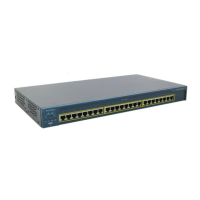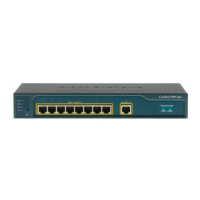30-5
Catalyst 2950 and Catalyst 2955 Switch Software Configuration Guide
78-11380-12
Chapter 30 Configuring EtherChannels
Understanding EtherChannels
The silent mode is used when the switch is connected to a device that is not PAgP-capable and seldom,
if ever, sends packets. An example of a silent partner is a file server or a packet analyzer that is not
generating traffic. In this case, running PAgP on a physical port connected to a silent partner prevents
that switch port from ever becoming operational; however, the silent setting allows PAgP to operate, to
attach the interface to a channel group, and to use the interface for transmission.
Note An EtherChannel cannot be configured in both the PAgP and LACP modes.
Exchanging LACP Packets
Both the active and passive LACP modes allow interfaces to negotiate with partner interfaces to
determine if they can form an EtherChannel based on criteria such as interface speed and, for Layer 2
EtherChannels, trunking state, and VLAN numbers.
Interfaces can form an EtherChannel when they are in different LACP modes as long as the modes are
compatible. For example:
• An interface in the active mode can form an EtherChannel with another interface that is in the active
mode.
• An interface in the active mode can form an EtherChannel with another interface in the passive
mode.
An interface in the passive mode cannot form an EtherChannel with another interface that is also in the
passive mode because neither interface starts LACP negotiation.
An interface in the on mode that is added to a port channel is forced to have the same characteristics as
the already existing on mode interfaces in the channel.
Note An EtherChannel cannot be configured in both the PAgP and LACP modes.
Caution You should exercise care when setting the mode to on (manual configuration). All ports configured in
the on mode are bundled in the same group and are forced to have similar characteristics. If the group is
misconfigured, packet loss or spanning-tree loops might occur.
Physical Learners and Aggregate-Port Learners
Network devices are classified as PAgP physical learners or aggregate-port learners. A device is a
physical learner if it learns addresses by physical ports and directs transmissions based on that
knowledge. A device is an aggregate-port learner if it learns addresses by aggregate (logical) ports.
When a device and its partner are both aggregate-port learners, they learn the address on the logical
port-channel. The device sends packets to the source by using any of the interfaces in the EtherChannel.
With aggregate-port learning, it is not important on which physical port the packet arrives.
The switch uses source-MAC address distribution for a channel if it is connected to a physical learner
even if you configure the switch for destination-MAC address distribution.
These frame distribution mechanisms are possible for frame transmission:
• Load distribution based on the source-MAC address of the packet
• Load distribution based on the destination-MAC address of the packet
The switch supports up to eight ports in a PAgP group.

